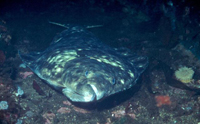NOAA Reduces Halibut Catch for Southeast Alaska Charter Anglers to Protect Stock
May 23, 2008
NOAA’s Fisheries Service issued a new rule today that states starting June 1, charter vessel anglers in southeast Alaska will be allowed to keep one instead of two halibut per day.
In addition, the number of lines used to fish for halibut must not exceed the number of anglers onboard the charter vessel, to a maximum of six lines. Also, guides and crew are not allowed to catch and retain halibut while clients are onboard.
“These new regulations are needed because charter fishing has grown in southeast Alaska while the abundance of halibut has decreased,” said Doug Mecum, NOAA’s Fisheries Service Alaska region acting administrator.
The North Pacific Fishery Management Council and NOAA’s Fisheries Service approved the new regulations to reduce the harvest of halibut to the new target level of 931,000 pounds in 2008 in the waters of southeast Alaska, which is International Pacific Halibut Commission Area 2C. The new regulations will remain in effect until further notice.
While the target harvest for southeast Alaska in 2007 was 1.4 million pounds, the actual amount of halibut harvested by charter anglers was estimated at more than 1.7 million pounds.
Sport anglers who are not aboard guided charter vessels may continue to keep two halibut of any size daily. Guided charter vessel anglers outside of Southeast Alaska may also continue to keep two halibut of any size per day.
A regulation implemented earlier this year to assist enforcement officers to count the number of fish each angler possesses, says anglers can cut their halibut on board into not more than two ventral and two dorsal pieces and two cheeks, all with the skin on.
NOAA’s Fisheries Service received many comments on the proposed regulations for the charter vessel fishery. A summary of those comments and the agency’s responses will be published with the final regulations online.
NOAA’s Fisheries Service is dedicated to protecting and preserving our nation’s living marine resources through scientific research, management, enforcement, and the conservation of marine mammals and other protected marine species and their habitat.
The National Oceanic and Atmospheric Administration, an agency of the U.S. Commerce Department, is dedicated to enhancing economic security and national safety through the prediction and research of weather and climate-related events and information service delivery for transportation, and by providing environmental stewardship of our nation's coastal and marine resources. Through the emerging Global Earth Observation System of Systems (GEOSS), NOAA is working with its federal partners, more than 70 countries and the European Commission to develop a global monitoring network that is as integrated as the planet it observes, predicts and protects.
